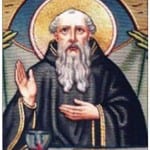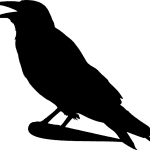Who Is St. Benedict?
 St. Benedict was born to a noble family around 480 A.D. in Nursia, in central Italy. He lived a sequestered life for many years, leaving family and friends behind to live in a cave near the town of Subiaco. St. Benedict chose to live a quiet life of prayer and devotion to God after disapproving of the immoral lifestyle he encountered while he attended school in Rome. Even though he lived a life devoted to God, St. Benedict (like all of us) was constantly tempted by the devil. St. Benedict was able to defeat the devil numerous times throughout his life, earning him the title of protector against evil spirits, temptation, and witchcraft. St. Benedict also offers protection against being poisoned, infectious diseases, childbirth complications, and destruction during storms and tempests. He also obtains for sinners the grace of conversion.
St. Benedict was born to a noble family around 480 A.D. in Nursia, in central Italy. He lived a sequestered life for many years, leaving family and friends behind to live in a cave near the town of Subiaco. St. Benedict chose to live a quiet life of prayer and devotion to God after disapproving of the immoral lifestyle he encountered while he attended school in Rome. Even though he lived a life devoted to God, St. Benedict (like all of us) was constantly tempted by the devil. St. Benedict was able to defeat the devil numerous times throughout his life, earning him the title of protector against evil spirits, temptation, and witchcraft. St. Benedict also offers protection against being poisoned, infectious diseases, childbirth complications, and destruction during storms and tempests. He also obtains for sinners the grace of conversion.
St. Benedict’s Protection — A Lifetime of Defeating the Devil
Pope Gregory I, also known as St. Gregory the Great, detailed St. Benedict’s encounters with the devil as part of his four-part book series, The Dialogues. Here are some examples of how St. Benedict defeated the devil.
The Miracle of the Poisoned Wine
 After living in solitude for a few years, St. Benedict was discovered by a group of monks who asked him to organize their monastery and become their abbot, or leader. Soon, however, the monks rejected St. Benedict’s leadership, feeling it was too strict and devised a plan to poison him. The monks offered St. Benedict a cup of poisoned wine, but before drinking it, St. Benedict—who greatly venerated the Holy Cross—blessed the cup with the sign of the cross.
After living in solitude for a few years, St. Benedict was discovered by a group of monks who asked him to organize their monastery and become their abbot, or leader. Soon, however, the monks rejected St. Benedict’s leadership, feeling it was too strict and devised a plan to poison him. The monks offered St. Benedict a cup of poisoned wine, but before drinking it, St. Benedict—who greatly venerated the Holy Cross—blessed the cup with the sign of the cross.
The cup immediately broke into pieces and his life was spared.
St. Benedict retreated back to his life of solitude, telling the monks “May Almighty God have mercy on you, and forgive you.” St. Benedict eventually went on to establish 12 monasteries and became known as the “father of western monasticism.”
The Black Bird
 During his time in seclusion, St. Benedict was visited by the devil, disguised as a blackbird. The blackbird flew very close to him, hovering near his face. Aware that this was the devil, St. Benedict blessed himself with the sign of the cross and the bird immediately flew away. Soon after, the devil tempted St. Benedict with the memory of a woman he once knew. He was so overcome by desire for this woman that he was tempted to leave his life of chastity. Suddenly, St. Benedict spotted large thorn bushes nearby and threw himself into them in the hopes of extinguishing his desire. When he got up, his flesh was badly torn and scratched, but he overcame his temptation. St. Benedict believed it was God’s grace that helped him resist the temptation of his flesh and avoid sin. He later described that by the wounds of his body he cured the wounds of his soul.
During his time in seclusion, St. Benedict was visited by the devil, disguised as a blackbird. The blackbird flew very close to him, hovering near his face. Aware that this was the devil, St. Benedict blessed himself with the sign of the cross and the bird immediately flew away. Soon after, the devil tempted St. Benedict with the memory of a woman he once knew. He was so overcome by desire for this woman that he was tempted to leave his life of chastity. Suddenly, St. Benedict spotted large thorn bushes nearby and threw himself into them in the hopes of extinguishing his desire. When he got up, his flesh was badly torn and scratched, but he overcame his temptation. St. Benedict believed it was God’s grace that helped him resist the temptation of his flesh and avoid sin. He later described that by the wounds of his body he cured the wounds of his soul.
St. Benedict Moves a Large Stone by the Power of Prayer
St. Benedict once again drove the devil away on a day when the monks were busy building a new monastery. As the monks were moving stones to use in the building of the structure, they came across a large stone that they weren’t able to lift. The group of monks repeatedly tried to move the stone, without success. They realized the devil was sitting on the stone, preventing it from being used in the building of the monastery. St. Benedict arrived and after praying, drove the devil away and was able to pick up the stone himself with little effort.
St. Benedict Medal—what do the images mean?
 The St. Benedict medal is filled with symbolic images. The front of the medal has the image of St. Benedict holding a cross in his right hand and The Rule of Benedict—a guide on how monks and nuns should live a balanced, simple, obedient, and prayerful life—in his left hand. The same rules are still used today, over 1500 years later.
The St. Benedict medal is filled with symbolic images. The front of the medal has the image of St. Benedict holding a cross in his right hand and The Rule of Benedict—a guide on how monks and nuns should live a balanced, simple, obedient, and prayerful life—in his left hand. The same rules are still used today, over 1500 years later.
To the right of St. Benedict is a cup with a serpent, representing the poisoned cup of wine that shattered after he blessed it. To his left is a raven with a loaf of bread. This image refers to the second attempt on St. Benedict’s life when a jealous enemy gave him a poisoned loaf of bread. God sent a raven to take the bread away. On each side of St. Benedict are Latin words meaning: “The Cross of the Holy Father Benedict.” Below his feet are the words: “From the Holy Monte Cassino, 1880.” This is the date that Monte Cassino (St. Benedict’s first monastery) was given exclusive rights to produce the medal. It was the 1400th anniversary of St. Benedict’s birth. Around the edge of the medal are the words: “May his presence protect us in the hour of death.”
Back of the St. Benedict Medal
 The back of the medal features a large cross in the center. The vertical beam of the cross has the letters: C.S.S.M.L., which represent the first letters of the words: Crux Sacra Sit Mihi Lux (May the Holy Cross be for me a light). The horizontal beam of the cross has the letters: N.D.S.M.D., the first letters of the words: Non Draco Sit Mihi Dux (Let not the dragon be my guide). The four large letters at the angles of the Cross: C S P B stands for Crux Sancti Patris Benedicti (The Cross of the Holy Father Benedict). Encircling the right edge of the medal are the initials for the words: Vade retro Satana; nunquam suade mihi vana (Begone Satan! Suggest not to me thy vain things). On the left edge of the medal are the initials for the words: Sunt mala quae libas; ipse venena bibas (The drink you offer is evil; drink that poison yourself). The word “Pax,” meaning “Peace” is inscribed on the top.
The back of the medal features a large cross in the center. The vertical beam of the cross has the letters: C.S.S.M.L., which represent the first letters of the words: Crux Sacra Sit Mihi Lux (May the Holy Cross be for me a light). The horizontal beam of the cross has the letters: N.D.S.M.D., the first letters of the words: Non Draco Sit Mihi Dux (Let not the dragon be my guide). The four large letters at the angles of the Cross: C S P B stands for Crux Sancti Patris Benedicti (The Cross of the Holy Father Benedict). Encircling the right edge of the medal are the initials for the words: Vade retro Satana; nunquam suade mihi vana (Begone Satan! Suggest not to me thy vain things). On the left edge of the medal are the initials for the words: Sunt mala quae libas; ipse venena bibas (The drink you offer is evil; drink that poison yourself). The word “Pax,” meaning “Peace” is inscribed on the top.
How You Can Use the St. Benedict Medal for Protection
The St. Benedict medal is a visible reminder to call on St. Benedict to be your intercessor before God to protect your body and soul from the dangers of evil. The medal can be worn on a chain around your neck, attached to a rosary, kept in a wallet or purse, or placed in your car or home. Many people also choose to place the St. Benedict medal in the foundation of houses and buildings they’re building, for years of protection.
